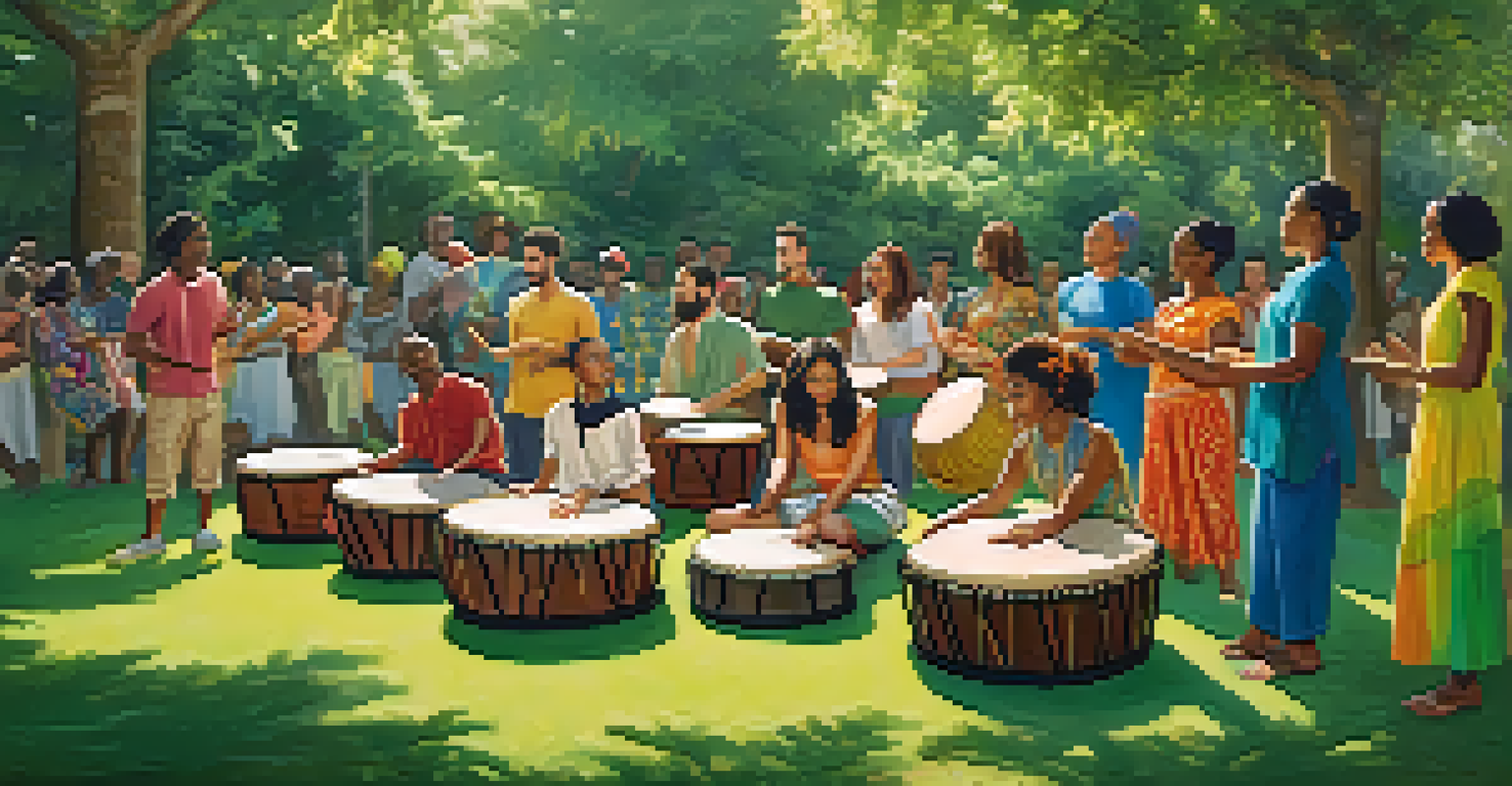How Music Facilitates Rituals in Various Spiritual Traditions

The Universal Language: Music in Spiritual Expressions
Music is often described as a universal language, transcending barriers and connecting people across cultures. In spiritual contexts, it acts as a powerful tool for expression, enabling individuals to convey emotions and intentions that words alone might fail to capture. For many, the melodies and rhythms associated with rituals serve as a bridge, linking the physical world to the spiritual realm.
Music can change the world because it can change people.
Whether it’s the haunting sounds of a Tibetan singing bowl or the rhythmic drumming in African ceremonies, each musical element carries deep cultural significance. This connection not only enriches the ritual experience but also fosters a sense of community among participants. The shared act of creating or listening to music during rituals can bring individuals together, strengthening bonds and enhancing collective experiences.
Moreover, music often evokes memories and feelings, making it a poignant aspect of spiritual practices. When combined with rituals, it has the power to transport individuals into a meditative state, allowing them to connect more deeply with their spirituality and the traditions they uphold.
The Role of Chanting in Different Faiths
Chanting is a common practice across various spiritual traditions, serving as a method to focus the mind and elevate the spirit. In Hinduism, for instance, the recitation of mantras is believed to bring about spiritual clarity and connection to the divine. These chants, often set to specific melodies, create a sacred atmosphere that enhances the overall ritual experience.

In Buddhism, chanting serves a similar purpose, with practitioners using it to cultivate mindfulness and compassion. The repetition of phrases, like 'Om Mani Padme Hum,' not only aids in meditation but reinforces the teachings of the Buddha. The melodic intonations weave through the air, creating a sense of peace and unity among those who participate.
Music as a Spiritual Connector
Music transcends cultural barriers, enhancing spiritual rituals and fostering a sense of community among participants.
This practice of chanting can also be found in Christianity, particularly in liturgical settings. Gregorian chants, for example, are used to elevate prayers and create a reflective environment, guiding worshippers into deeper spiritual contemplation. The rhythmic and melodic qualities of these chants help to create a transcendent experience, drawing individuals closer to their faith.
Instrumental Music in Sacred Ceremonies
Instrumental music plays a pivotal role in many sacred ceremonies, often setting the tone for the entire ritual. In Native American traditions, for instance, drums are central to many ceremonies, believed to connect participants with the heartbeat of Mother Earth. The deep, resonant sound of the drum fosters a sense of grounding and community, essential for spiritual gatherings.
Where words fail, music speaks.
Similarly, in Jewish rituals, instruments like the shofar or the harp may be used during significant events. The shofar, a ram’s horn, is blown during Rosh Hashanah to awaken the spirit and signal a time of reflection. The unique sounds created evoke a rich spiritual atmosphere, enhancing the communal experience of worship.
Moreover, in various African traditions, the use of instruments such as the kora or mbira adds layers of meaning to rituals. Each instrument carries its own cultural significance and is often played during specific ceremonies to invoke ancestral spirits, celebrate life events, or mark transitions. The melodies produced resonate deeply within the community, reinforcing shared beliefs and values.
Dance and Music: A Harmonious Spiritual Union
Dance is often intertwined with music in spiritual rituals, creating a dynamic form of expression that engages both the body and spirit. In many Indigenous cultures, dance is a way to celebrate important events and express gratitude to the spirits. The rhythmic movements, paired with music, create a vibrant atmosphere that enhances the communal experience of the ritual.
In Sufi traditions, whirling dervishes use dance as a form of meditation, accompanied by traditional music. This sacred dance allows participants to lose themselves in the rhythm, fostering a deep sense of connection with the divine. The music serves as both a backdrop and a catalyst, guiding the dancers into a trance-like state.
Chanting Enhances Spiritual Focus
Chanting serves as a method to elevate the spirit and focus the mind across various faiths, enriching the overall ritual experience.
Furthermore, in Hindu festivals, the colorful dances performed in tandem with devotional songs create an atmosphere of joy and reverence. Dancers tell stories of deities through their movements, while the accompanying music elevates the emotional impact of the performance. This synergy between music and dance enhances the spiritual connection for both performers and attendees.
Music's Healing Power in Spiritual Contexts
Music is often recognized for its healing properties, particularly within spiritual practices. In many cultures, specific musical tones and frequencies are believed to promote physical and emotional healing. For example, sound therapy is used in various traditions to balance energy and restore harmony within individuals, making music a vital component of spiritual wellness.
In some Native American healing ceremonies, chants and songs are employed to call upon the spirits for guidance and healing. The rhythmic patterns and melodic lines are thought to resonate with the energies of the body, facilitating a sense of balance and tranquility. Participants often leave these ceremonies feeling rejuvenated and spiritually aligned.
Additionally, in modern practices like sound baths, crystal bowls, and Tibetan singing bowls are used to create a soothing environment that promotes relaxation and meditation. The sound waves produced are said to penetrate deeply into the body, releasing tension and fostering a sense of peace. This highlights the transformative power of music in spiritual healing practices, allowing individuals to reconnect with their inner selves.
Rituals of Transition: Music in Life-Cycle Events
Life-cycle rituals, such as births, weddings, and funerals, often feature music as a cornerstone element. These significant events are marked by specific songs or musical traditions that convey the gravity and joy of the occasion. For example, in many cultures, lullabies are sung to newborns, symbolizing love and protection as they enter the world.
Weddings often feature music that reflects the couple's cultural background and personal connection, creating a memorable experience for all involved. In many traditions, the processional and recessional music sets the tone for the ceremony, guiding participants through the emotional journey of joining two lives. The melodies chosen often resonate with shared stories and hopes for the future.
Healing Through Musical Frequencies
Music plays a vital role in spiritual healing practices, using specific tones to promote emotional and physical well-being.
Funerals also incorporate music as a means of honoring the deceased and providing comfort to mourners. In many cultures, specific hymns or songs are played to celebrate the life of the departed, allowing attendees to remember and reflect. The emotional weight of these musical selections highlights the profound connection between music and the human experience of transition and loss.
Conclusion: The Enduring Connection Between Music and Spirituality
As we’ve explored, music is a vital thread woven through the fabric of spiritual traditions worldwide. It enhances rituals, fosters community, and facilitates personal connection to the divine. Whether through chanting, instrumental accompaniment, or dance, music enriches the spiritual experience, allowing individuals to delve deeper into their beliefs and practices.
The adaptability of music across cultures demonstrates its universal significance in human expression. From the ancient rhythms of Indigenous tribes to the melodic chants of modern spiritual practices, music continues to play an essential role in rituals that shape our lives. It invites us to celebrate, mourn, and reflect, creating a shared language of emotion and spirituality.

Ultimately, the relationship between music and spirituality is a testament to our innate desire for connection and meaning. As we navigate our own spiritual journeys, let us remember the power of music to elevate our experiences and foster a deeper understanding of ourselves and the world around us.